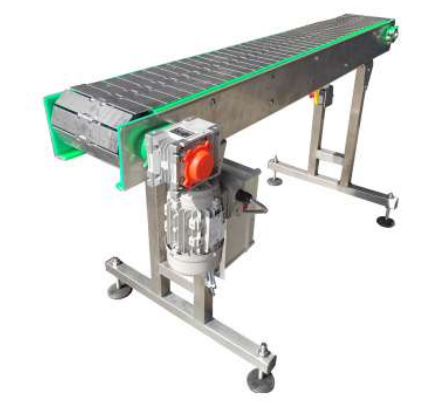A slat chain conveyor is a versatile conveyor system designed to handle heavy, sharp, or irregularly shaped items. It consists of slats, typically made from metal or plastic, attached to chains that move the products along the conveyor path. Here’s an in-depth look at the components, design, applications, benefits, and maintenance of slat chain conveyors:

Components
- Slats
- Material: Often made from metal (steel or aluminum) or durable plastic.
- Design: Flat, rectangular pieces attached to the chain, creating a continuous surface for products to rest on.
- Spacing: Can be closely spaced for smaller items or widely spaced for larger items.
- Chains
- Material: Made from steel or other strong metals.
- Design: Links that connect to the slats and drive the conveyor.
- Types: Single or double strand chains, depending on load requirements.
- Frame
- Material: Constructed from steel or aluminum for strength and durability.
- Design: Provides the structural support for the slats and chains.
- Shape: Can be straight, curved, or inclined based on the application.
- Drive System
- Motor: Powers the chains and slats.
- Gearbox: Transmits power from the motor to the chains.
- Drive Sprockets: Engage with the chains to move the slats.
- Idler Sprockets
- Location: Placed at the ends of the conveyor to guide the chains and slats.
- Function: Ensure smooth and controlled movement of the conveyor.
- Support Structure
- Leg Supports: Adjustable in height to ensure the conveyor is level.
- Stability: Legs are designed to provide a stable base, preventing wobbling or tipping.
- Side Rails and Guards
- Material: Typically made from metal or plastic.
- Function: Prevents products from falling off the sides of the conveyor.
- Accessories
- End Stops: Prevent products from falling off the end of the conveyor.
- Guide Rails: Help keep products centered on the conveyor.
- Sensors: For detecting product presence and controlling conveyor operation.
Applications
- Automotive Industry: Handling car parts and components.
- Manufacturing: Moving heavy machinery parts and equipment.
- Food and Beverage: Transporting bottles, cans, and containers.
- Packaging: Moving packaged goods, cartons, and boxes.
- Pharmaceuticals: Handling packaged medications and medical devices.
Benefits
- Durability: Can handle heavy loads and resist wear and tear.
- Versatility: Suitable for a wide range of products, including those with sharp or irregular shapes.
- Stability: Provides a stable and flat surface for products.
- Customization: Can be customized in terms of length, width, and configuration to meet specific needs.
- Safety: Reduces the risk of product damage and ensures safe handling of items.
Design Considerations
- Load Capacity: Ensure the conveyor is designed to handle the maximum load of the products being conveyed.
- Speed: Determine the appropriate conveyor speed for efficient product handling without causing damage.
- Layout: Design the conveyor layout to fit the available space and workflow requirements.
- Product Specifications: Consider the size, shape, and weight of the products being conveyed.
- Environmental Conditions: Consider factors such as temperature, humidity, and exposure to chemicals when selecting materials.
- Safety Features: Incorporate guards, sensors, and emergency stop mechanisms to ensure safe operation.


